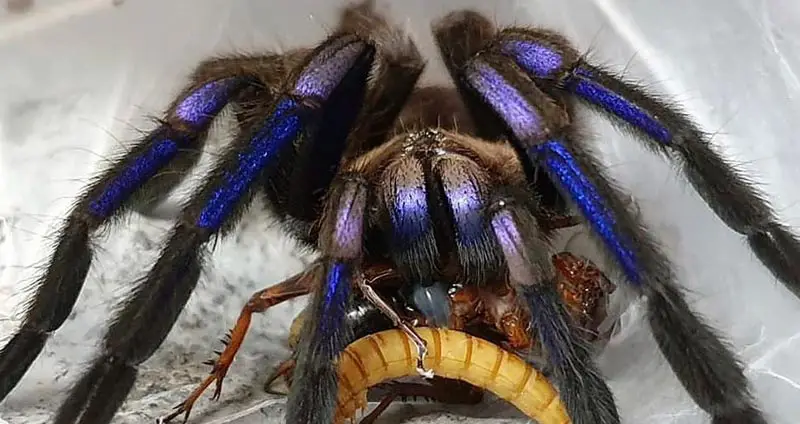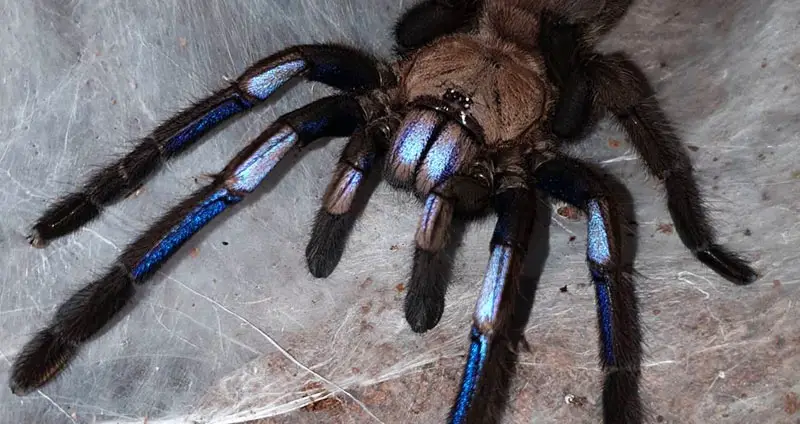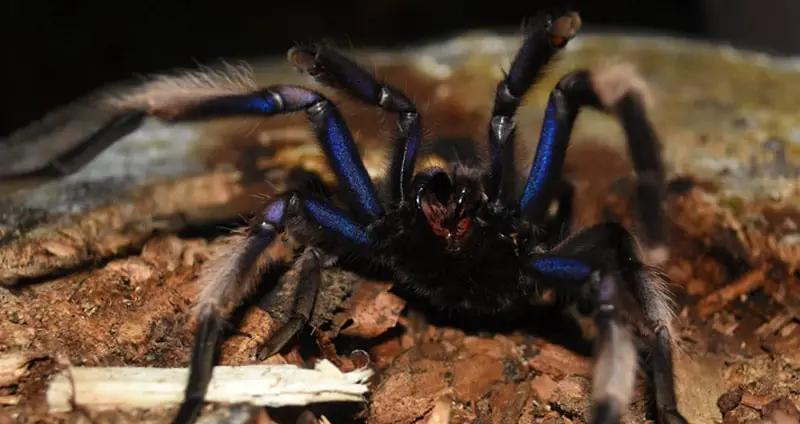Within the past couple of years, the Chilobrachys sp. Electric Blue has been one of the most-admired and sought-after tarantulas — for quite a good reason!
While their overall genus is quite impressive, this tarantula takes its physical appearance to the next level. This post will review the unique appearance of the Chilobrachys sp. Electric Blue, in addition to their temperament and their dietary and environmental needs.
Table of Contents
Chilobrachys sp. Electric Blue Care Sheet
Scientific Name |
Chilobrachys dyscolus |
Species Type |
Old world terrestrial |
Habitat |
Found in Vietnam, this tarantula experiences quite a diverse climate. Temperatures range from 60°F to 90°F, and humidity levels are decently high. Therefore, this tarantula spends most of its time in burrows. |
Growth Rate |
Medium-to-fast growth rate. Females reach full size in about 3 years, with males maturing slightly faster. |
Adult Size |
Females reach a legspan of between 5″ and 6″, with males measuring slightly smaller. |
Lifespan |
Females regularly live between 10 and 12 years, while males often only live to 3 years. |
Enclosure |
The enclosure needs to be much wider than it is tall. The bottom of the enclosure should contain several inches of substrate to burrow into, and it should also contain a sizable hide and a well-maintained water dish. |
Temp/Humidity |
75°F to 80°F with about 70% to 80% humidity. |
Diet |
Good eater that can eat several adult-sized crickets per week. Dubia roaches and mealworms should be used as supplemental food. |
Temperament |
Quite an aggressive and mean tarantula. It prefers to run instead of fight, but can deliver a very painful bite with especially potent venom. It spends most of its time within its burrow. |
Experience Level |
Advanced – This is not a tarantula for beginners. It is quite aggressive and has one of the most painful bites among tarantulas. It may be easy to provide it with a comfortable environment, but its personality is not good for beginners. |
Average Cost |
Slings ~ $100, Males ~ $150, Females ~ $200+ |
Chilobrachys sp. Electric Blue Appearance
The reason why this tarantula species has become so well-received within the past couple of years is its phenomenal appearance. This tarantula differs from other Chilobrachys with the brilliant blue coloring on its upper front legs and pedipalps.
This coloring is visible when the tarantula is under the correct lighting, and it only gets better and more pronounced as it ages. Female specimens tend to have better and brighter coloring than the males.
Other than this blue coloring, there isn’t too much that makes this particular tarantula very different. Chilobrachys in general are quite plain-looking tarantulas with brownish-gray coloring and a wide prosoma.
These tarantulas are a bit on the smaller side, with slings being notably tiny and adults generally not exceeding a 6 inch leg span. However, they can grow quite quickly, so make sure that you’re able to supply them with enclosures that contain them safely and effectively.

Chilobrachys sp. Electric Blue Temperament
While Chilobrachys sp. Electric Blues can be very nice to look at, they aren’t known for their calm demeanor. The Chilobrachys genus is not one that should be handled regularly (you should never handle a tarantula) or kept by inexperienced tarantula keepers.
Their quick, erratic movements can make them hard to predict, and this can result in bad consequences for both the tarantula and the owner.
While Chilobrachys are a genus that are more willing to run away from trouble than fight it, they aren’t tarantulas that you’d want to try your luck with. Chilobrachys are old world tarantulas, resulting in them having an aggressive personality and a more painful bite.
Of the old worlds, Chilobrachys are particularly aggressive and have some of the most potent venom. Some bite victims reported fevers, chest pains, and localized throbbing and swelling.
Despite the overall aggressiveness of this genus, the Chilobrachys sp. Electric Blue makes for an amazing tarantula to keep. Their unique mannerisms are what make them a favorite genus among collectors, despite their typical boring appearance.
They tend to make some fascinating webbing, respond to feeding well, grow quickly, and are quite fierce. Some females will even try to chase you out of their enclosure!
One disappointing trait with Chilobrachys is that they’re a fossorial genus, meaning that they live in burrows and don’t come out very frequently. When you purchase a Chilobrachys sp. Electric Blue, you’re doing so because of its beautiful blue colors.
It’s mildly disappointing that you don’t get to see those colors all the time. However, when you do, it’s quite a treat.
Housing Chilobrachys sp. Electric Blue
If you’re thinking about bringing home one of these tarantulas, you need to ensure that you can provide it with the proper enclosure. Chilobrachys is a burrowing genus, meaning that its setup needs to revolve around the ability to create a large burrow.
Since they have evolved while utilizing burrows, it’s essential that they’re able to create one to prevent strange or potentially destructive behavior.
Optimal Enclosure
Chilobrachys sp. Electric Blues do have special requirements for their enclosures, but they aren’t difficult requirements to meet. First of all, these are terrestrial tarantulas that need to burrow, so their enclosure should have a focus on floor space and shouldn’t be too tall.
While they aren’t a large genus, Chilobrachys should have an enclosure that’s about 2-3x their legspan to give them adequate space. Something like this Exo Terra 18″ x 18″ x 12″ glass terrarium should work for a full-grown adult.
This particular terrarium is wide enough to give a Chilobrachys plenty of room while not being tall enough to potentially cause problems if your tarantula decides to climb.
Enclosure Decorations
The inside of the enclosure needs to feature a few accessories in order to make it habitable for this species.
First of all, about 6 inches of moisture-retaining substrate needs to line the bottom of the enclosure to allow for burrowing and to keep the humidity of the enclosure consistent.
Coconut fiber substrate works well for this.
Then, on top of the substrate you should provide a cork bark hide and a water dish. The hide acts as shelter for Chilobrachys sp. Electric Blue while the water dish contributes to humidity and prevents dehydration.
I wouldn’t recommend that you add anything else after those few things. As this is a heavy-webbing species, you don’t want to limit their web-making abilities.

Enclosure Temperature/Humidity
In the wild, Chilobrachys experience a wide array of different temperatures. In the winter, they can experience temperatures as cold as 60°F and the summer can bring temperatures as hot as 87°F+.
This genus is able to shield themselves from extreme temperatures by hiding in their deep burrows. Despite this, there is still an optimal temperature that your Chilobrachys sp. Electric Blue should be kept at.
You should always keep your tarantula around room temperature, which is 75°F to 80°F.
If your home over dips below this range of temperatures, though, you’ll need to provide supplemental heating. Heat mats generally aren’t recommended as they can burn your tarantula — especially when they burrow down so close to the bottom of their terrarium.
Therefore, the best solution for this is a gentle heat lamp that can be turned off and on as needed, or a space heater to warm the entire room.
Additionally, Chilobrachys sp. Electric Blues need to have a humid enclosure — around 70% to 80% humidity. This can be maintained by keeping the substrate and moss in the enclosure damp, but don’t make it wet.
You can add a simple hygrometer to the enclosure to calculate when you should dampen your tarantula’s substrate again.
Diet
These aggressive tarantulas definitely enjoy eating, so they should be given a healthy, consistent diet. Since tarantulas can’t be overfed, it’s always a better idea too much food than too little food.
While this genus has a wild diet that consists of a wide selection of different insects, they don’t need to be fed those exact same bugs. The most commonly-fed foods to Chilobrachys are crickets, roaches, and even locusts on occasion.
It’s always recommended that tarantula keepers vary their tarantula’s diet to keep things more interesting and provide a more diverse array of nutrients. Larger specimens can even be given pinky mice as a rare, messy treat.
One thing to note is that when your Chilobrachys sp. Electric Blue starts to molt, they’ll start eating much less and eventually stop altogether. Since these tarantulas stay in their burrows most of the time, they’ll most likely molt down there, too.
After the molt is complete, they should emerge from their burrow and begin eating in about a week or two.
Health Concerns
If you provide your Chilobrachys with an optimal enclosure and they have a good diet, then they shouldn’t experience any health issues in their lifetime. Captive tarantulas rarely run into health problems besides mites and dehydration, and both of those things can be dealt with quickly.
There are two things that you should be aware of with your Chilobrachys. First of all, you need to ensure that they can form a proper burrow. If they can’t, they may start exhibiting strange behavior and even start climbing the terrarium like an arboreal would.
To prevent this, make sure that they have plenty of damp substrate that can be moved around to form a burrow.
Additionally, some tarantulas may run into problems with their molt. Most molts happen without any problems, but sometimes they may get stuck.
In this case, you need to perform the dangerous but necessary task of removing their exoskeleton. Fortunately, there are a lot of guides available that help owners remove their tarantula’s bad molt.
Chilobrachys sp. Electric Blue For Sale & Price
Electric Blue is a subspecies that has only been bred for the past couple of years, mostly beginning back in 2016. Although these tarantulas are not good for beginners at all and stay hidden most of the time, they would still fetch a lot of money.
Back when they first became known, spiderlings were selling for over $200. Fortunately, over time, this price has come down a bit.
Several different online exotic sellers and marketplaces have Chilobrachys sp. Electric Blues for sale. You can purchase spiderlings for anywhere from $90 to $150 depending on the breeder.
As these are still relatively new tarantulas that haven’t been bred extensively yet, there is still a lot of room for their prices to come down over time.
However, for such a stunning, new, exciting tarantula, $100 for a Chilobrachys sp. Electric Blue isn’t a bad deal if you’re a tarantula enthusiast. These tarantulas are so fascinating to observe feeding, burrowing, or even just laying around.
They’re not for everybody, but the right people can definitely appreciate this species.

